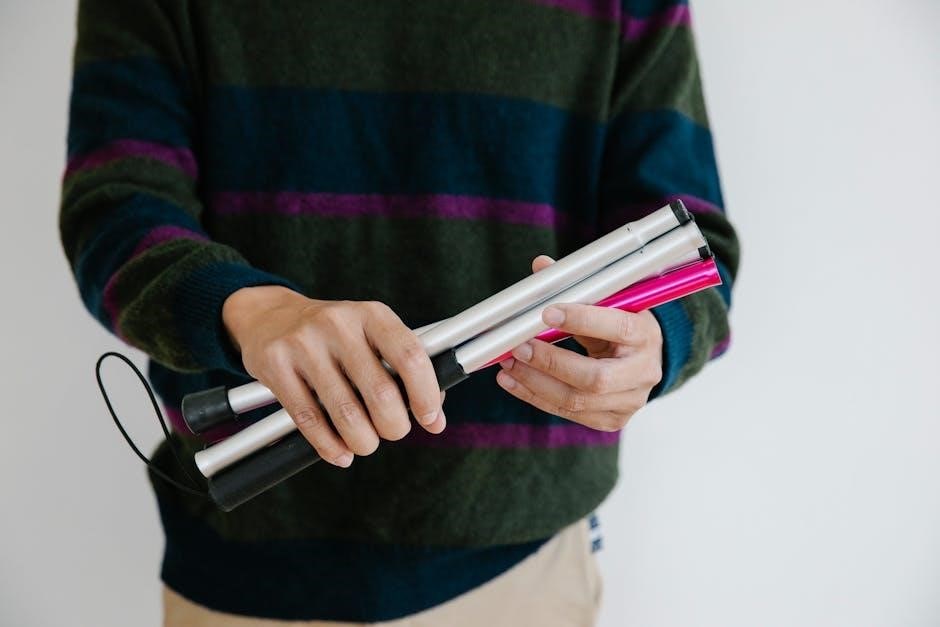Ring sizing is crucial for ensuring a comfortable and proper fit․ This guide provides methods and tools to accurately determine your ring size, whether at home or professionally․
Why Ring Size Matters
Accurate ring sizing ensures comfort and prevents issues like slipping off or discomfort․ A properly fitted ring enhances functionality and aesthetic appeal, making it essential for both everyday wear and special occasions․ Incorrect sizing can lead to discomfort or damage, while the right size guarantees satisfaction․ Band width also plays a role, as wider bands require a slightly larger size for a snug fit․
Understanding Ring Size Charts
Ring size charts are essential tools for determining accurate measurements․ They often display sizes in different international standards, such as US, UK, or EU measurements․ These charts typically correlate finger circumference or diameter with corresponding ring sizes․ By using a chart, individuals can match their measured finger size to the appropriate ring size, ensuring a perfect fit․ Printable charts are widely available online for easy at-home use․
How to Measure Your Ring Size
Accurate measurement ensures a comfortable fit․ Use methods like string, paper, or a ring sizer to determine size, considering factors like finger fluctuations and band width․
Using a String or Paper
Wrap a non-stretchy string or paper strip around your finger, ensuring it fits snugly but not too tight․ Mark where the ends overlap, then measure the length in millimeters․ Compare this to a ring size chart to find your size․ For accuracy, measure in the evening when fingers are largest․ This method is simple and effective for determining your ring size at home․ Ensure the fit is comfortable and allows the ring to slide over the knuckle easily․
Using a Ring Sizer
A ring sizer is a plastic tool with numbered holes, each representing a different size․ Place the ring onto the sizer and ensure it fits comfortably, sliding over the knuckle without resistance․ This method provides precise measurements, ensuring accuracy and comfort․ It’s a highly recommended tool for determining your ring size accurately, offering a reliable way to find the perfect fit for your finger․
Measuring an Existing Ring
To measure an existing ring, place it on a ruler or use a ring sizer․ Ensure the ring lies flat and measure the internal diameter in millimeters․ Compare this to a ring size chart to determine the corresponding size․ For accuracy, measure multiple rings of the same finger․ This method is ideal for determining your size discreetly, especially when purchasing a gift or resizing an heirloom piece․

Factors Affecting Ring Size
Finger size fluctuations, band width, and knuckle size influence ring fit․ Temperature and health conditions can cause size changes, while wider bands may require a larger size․
Finger Size Fluctuations
Finger size can change due to temperature, health, and activity levels․ Measure at the end of the day for accuracy, as fingers tend to swell slightly․ Weather conditions, hydration, and physical activity can cause fluctuations․ Ensure measurements are taken when fingers are at their average size for the best fit․ Consistency is key to avoiding resizing needs․ This ensures comfort and proper ring fit․
Band Width Considerations
Band width significantly impacts how a ring fits․ Wider bands require a slightly larger size for comfort, while narrower bands fit more snugly․ Measure your finger considering the width of the ring you plan to wear․ Thicker bands may need a half size larger to ensure ease․ Always account for band width when selecting your ring size to avoid discomfort or tightness․ Proper sizing ensures optimal wearability and satisfaction․
Knuckle Size
Knuckle size plays a crucial role in determining ring fit․ Larger knuckles may require a slightly bigger size to ensure the ring slides on comfortably․ Measure around the base of the finger, ensuring the ring can pass over the knuckle; If your knuckle is significantly larger than the base, consider a half size up for ease․ Proper measurement ensures the ring sits securely without being too tight or difficult to remove․

International Ring Size Conversion Chart
An essential reference for comparing ring sizes across different countries․ This chart helps match measurements to international standards, ensuring a perfect fit regardless of regional sizing differences․
Understanding Different Sizing Standards
Ring sizing standards vary globally, with the US using numerical sizes, while the UK and Australia use alphabetical sizing, and Europe often measures by inner diameter in millimeters․ These differences require careful conversion to ensure accuracy․ Using an international ring size conversion chart helps match your size across regions, avoiding discrepancies and ensuring a precise fit․ This understanding is essential for shopping across borders or comparing sizes from different retailers․
Converting Measurements
Converting ring measurements requires precise alignment between different sizing systems․ To convert circumference to diameter, divide by π (3․14)․ For international sizes, match millimeter measurements to corresponding alphabetic or numeric sizes using a conversion chart․ This ensures accuracy when transitioning between US, UK, or European standards․ Utilize online calculators or charts to seamlessly translate your measurements, guaranteeing the perfect fit across varying sizing systems worldwide․
Choosing the Right Method for You
Selecting the right method ensures accuracy and convenience․ Use at-home tools like string or paper for simplicity, or opt for professional measurement for precision․ Consider your preference and availability to determine the best approach for your needs․
At-Home Methods
At-home methods offer convenience and ease for measuring your ring size․ Use a string or paper to wrap around your finger, marking where it overlaps, and measure the length․ Alternatively, print a ring size chart and compare an existing ring’s fit․ For accuracy, measure at the end of the day when fingers are largest․ Consider the band width, as wider rings may require a larger size․ Repeat measurements for consistency and reliability․
Professional Measurement
Professional jewelers use precise tools to ensure accurate ring sizing․ They measure finger circumference or ring diameter, considering factors like knuckle size and band width․ Expert sizing avoids resizing needs, providing a perfect fit․ This method is recommended for significant purchases, ensuring comfort and satisfaction with minimal adjustments․ Professional measurement is the most reliable way to determine your ring size accurately․

Printable Ring Size Guide
A printable ring size guide offers a convenient way to measure your finger or existing rings․ Download and print the chart at home for accurate sizing․
Downloading and Using the Chart
Download a printable ring size guide to measure your finger or an existing ring․ Ensure the chart is printed at 100% scale for accuracy․ Wrap a string around your finger, mark the overlap, and compare the length to the chart․ For an existing ring, measure its internal diameter and match it to the sizing table․ This method provides a reliable way to determine your ring size comfortably at home․
Ensuring Accuracy
Accurate ring sizing is crucial for comfort and proper fit․ Measure your finger at the end of the day for the most reliable results, as fingers can swell․ Use a ruler or string to record circumference, then compare with a ring size chart․ Consider factors like temperature and knuckle size, as these can affect measurements․ For the best fit, measure multiple times and consult a professional jeweler if unsure․

Ring Sizing Tools and Resources
Utilize ring sizers, strings, or printable charts to measure accurately․ Professional tools and online resources provide reliable methods to determine your perfect ring size effortlessly․
Ring Sizer Tools
Ring sizer tools are essential for precise measurements․ These tools, often provided by jewelers, include plastic or metal rings in various sizes․ To use, slide the tool over your finger until it fits snugly but not too tightly․ Ensure it can pass over the knuckle for an accurate fit․ Professional tools offer reliable results, while at-home ring sizers are convenient for initial sizing․ Always use a ring sizer tool for the best fit and comfort․
String or Paper Method
This simple method involves wrapping a non-stretchy string or paper strip around the base of your finger․ Mark where the ends overlap, then measure the length with a ruler․ Compare this to a size chart to find your ring size․ Ensure the fit is snug but not tight, and the string can slide over the knuckle․ Measure multiple times for accuracy, as finger size can vary throughout the day․ This at-home technique is quick and effective for determining your perfect fit․
Best Time to Measure Ring Size
Measure your ring size in the evening when fingers are largest for comfort and accuracy․ Avoid measuring after extreme temperature changes or physical activity․
Time of Day
The best time to measure your ring size is in the evening when your fingers are at their largest due to natural swelling․ Avoid measuring in the morning or after extreme temperature changes, as fingers can shrink or swell․ Consistency is key for accuracy, so ensure you measure at the same time daily․ This helps in getting a size that remains comfortable throughout the day․
Physical Conditions
Physical conditions like temperature, humidity, and health can affect finger size․ Cold temperatures cause fingers to shrink, while heat and humidity can lead to swelling․ Medical conditions, such as arthritis or fluid retention, may also impact size․ Weight changes and pregnancy can alter finger measurements․ For accuracy, measure your ring size when your body is in a neutral state, avoiding extreme conditions that might temporarily change your finger size․
Accurate ring sizing ensures comfort and satisfaction․ Measure at the right time, consider physical conditions, and maintain your ring for a perfect fit․ Resizing is always an option if needed․
Final Tips for Accuracy
- Measure your finger at the end of the day for the most accurate fit․
- Consider temperature changes, as fingers swell in heat and shrink in cold․
- Use multiple methods to confirm your size, like string, ruler, or a professional sizer․
- If unsure, opt for a slightly larger size, as rings can be resized․
- Account for band width, as wider rings may require a larger size․
Accuracy ensures comfort and satisfaction, making your ring a perfect fit․
Maintenance and Resizing
Regularly clean your ring to prevent grime buildup, ensuring its longevity․ Store rings separately to avoid scratches․ If your ring feels too tight or loose, resizing may be necessary․ Resizing is typically possible but can be complex depending on the design․ For significant size changes, consult a professional jeweler for an accurate assessment․ Proper care and adjustments ensure your ring remains comfortable and secure over time․



